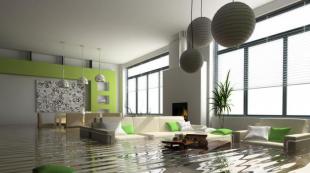In a Chinese metropolis, a railway runs right through a residential building. A miracle of Chinese architecture - a monorail through a residential building in Chongqing An electric train passes through a house
In a Chinese metropolis Chongqing extremely dense buildings make it almost impossible to implement new architectural or engineering projects. Therefore, designers sometimes have to make rather extreme decisions. So, in one of the city districts you can see how the monorail passes right through a 19-story building.

The topography of Chongqing is quite complex. The metropolis has many hills, which is why it is nicknamed “Mountain City”. In addition, there is very dense construction there. It was this problem that architects and engineers faced when laying the monorail line. When a 19-story residential building stood in their way, which was impossible to go around or demolish, the designers came up with a brilliant solution: build a railway through the building. The monorail passes through the opening between the 7th and 8th floors. A stop for passengers was also installed there.


The constructed tunnel is in contact with the walls of the apartments. Many people are interested in the question: are the residents of the house bothered by the roar from the train? The developers claim that the noise (60 decibels) from a train passing through the house causes people as much disturbance as someone else's conversation at the next table in a restaurant.


According to the developers, building a monorail on this site was a risky endeavor, but it more than paid off.
A train passing through a residential building is not the most original thing the Chinese could come up with. Opened in Hubei Province last year
The Chinese city of Chongqing has very dense buildings, so engineers sometimes have to make unusual decisions to implement new architectural projects.
Thus, during the construction of the monorail, a 19-story residential building stood in the way of the architects, which could not be demolished or bypassed.
The designers made an extreme decision: to build a railway directly through the building, between the 7th and 8th floors. There is also a 150-meter-long platform and a stop for passengers.
It would seem that such close proximity to the railway should cause residents a lot of trouble. But they claim that the roar of trains can be compared to the noise of a washing machine.
It is not surprising that the high-rise has become a landmark of Chongqing. The price per square meter has also increased - now housing here is the most expensive in the area. Many people dream of living next to the metro; who would refuse the opportunity to get off the train and immediately find themselves at home?

Japanese specialists came to the aid of Chinese architects. They have experience in similar construction - in Osaka they built an elevated expressway through a 16-story building.
In 1983, the land owners decided to redevelop the property, but city officials prohibited changes to the approved road construction plan. However, the owners found a compromise with the company building the highway. As a result, the road ran between the 4th and 8th floors of the high-rise building. A special structure around the highway protects the house from vibrations and noise.

The Chinese are literally no stranger to finding workarounds when building roads. In the city of Wenling in Zhejiang Province, a road had to be built through a densely populated area. Almost all the owners whose houses interfered with construction agreed to be relocated. Only one family prevented the government from demolishing their home. The end result was a house in the middle of the road.

Sources: http://www.novate.ru/; picslife.ru
For many cities around the world, it is a completely common form of urban transport. But you definitely won’t see such an option as in the Chinese city of Chongqing anywhere else - here the monorail route runs right through an apartment building!

The multimillion-dollar city of Chongqing is located in the central part of the country and is one of the largest commercial and industrial centers in China. The metro, opened here in 2005, has two monorail lines, one of which was built directly through a large 19-story residential building.

From the point of view of proximity to transport, this house can be called simply ideal, because it is in it that the Liziba metro station occupies two entire floors. Moreover, the distance from the train passing through the building to the walls of the apartments located in it is less than a meter.

One can only guess how the residents themselves feel about the monorail running through their house. Some online publications report that the noise and vibrations from a passing train are practically inaudible, so they don’t particularly bother anyone. Others, on the contrary, argue that many of its residents experience great inconvenience and suffer from regular headaches.

The appearance of a monorail in a residential building is explained quite simply. The unique decision to run the metro through an apartment building was made in order not to demolish the already constructed building and not to resettle its many residents. There is not so much space for a railway in the large, densely populated city of Chongqing, so the authorities made such a non-standard, but rational, in their opinion, decision.

The metro station is located in the building itself. No noise, no powerful vibration - apartment owners do not regret their choice. And the high-rise has become a new attraction.
The urban landscape looks like it's from the future. In Chongqing, China, a subway train seems to be flying straight through high-rise buildings. The transport solution is, to put it mildly, non-standard. Although it couldn’t be otherwise here.
It would seem, what kind of metro is there? There are no conditions: on one side there is a big river, on the other there are steep hills. But you can’t go underground because of the nature of the soil. In addition, there is very dense construction on the surface, the houses are window to window.
And so Chinese engineers were the first in the world to decide to stretch a branch through buildings. And even equip a station right inside a residential building.
The monorail platform is 150 meters long on the eighth floor of a 19-story building. The house was designed taking into account the station in it. Japanese engineers were even invited to help with this unprecedented project. After all, they also have little space in their country; in Osaka, for example, they built a city highway through a high-rise building. And, of course, the first question that comes to mind: is there a lot of extraneous noise in the house?
“No more noise than a washing machine. If the wheels of a regular metro are metal, then the monorail has rubber wheels; there is practically no sound from their contact with the tracks. In addition, we developed a special structure design in which the upper building is separated from the monorail system, although from the outside they appear to be a single structure,” says Ye Hong, the station’s project architect.
“There were doubts, we were afraid that there would be a roar. Nobody believed in the builders' persuasion, so the apartments were very cheap at first. We took advantage of this and were not disappointed!” - the owner of one of the apartments, Li Xuan, rejoices.
Now the price per square meter in this house is the highest in the area. What previously scared off buyers now attracts them. Isn’t this the dream of a metropolis resident – he got off the subway and is already home!
“There’s very little vacant property there right now. Despite the price, apartments still do not stay in our database. Moreover, buyers are of all ages,” says realtor Ma Gan.
These girls rent an apartment for two right above the station. Both often stay late at work. They say it’s also safe to live here, because you don’t have to walk home through dark streets.
“We don’t worry about each other, you always know exactly when you’ll return home,” says one of the girls.
“Yes, very comfortable and quiet. Besides, everyone in the city knows this house,” adds another.
“I just arrived in the city yesterday. And today the first thing I come here is to look at this amazing structure!” - says the tourist.
“It’s not so much beautiful as it is interesting in terms of architectural design!” - notes a tourist, a student of the Faculty of Architecture.
This is not an ancient building; there are no memorial plaques or sculptures on the facade. And this address cannot be found in the guidebook yet. But there are tourists around the house at every turn. A similar project - a station in a building - was tried on both Shanghai and Hong Kong. But this house is still the only one like it in the whole world!
credit: CFP
Due to the unique topography and high density of buildings in the city of Chongqing, one of the most densely populated in China, architects and urban planners were forced to find a special way to lay out the route vital to the city. Their solution was to appear railway passing through an inhabited house. And this is not a joke, today in Chongqing you can see an impressive sight when several times a day trains pass right through a 19-story residential building! The architects were forced to take this step because the city was built in a hilly area and is surrounded on all sides by the mountains of Daba, Wushan, Wuling and Dalo. This fact, coupled with the lack of space due to high density housing and a population of approximately 49 million people, makes infrastructure work a real challenge for architects and urban planners.
In Chongqing, a monorail passes through an occupied building.
In 2004, when the launch of the monorail was approved "Rail Transit No.2", the builders had two options to choose from - either demolish the entire apartment building to make way for the railroad, or convert it to just two floors so that a train could pass through it. The architects chose the second option and today, 13 years later, they are confident that they made the right choice then. In addition to the monorail train passing through the middle of the residential building, there is also a passenger station built on its 7th and 8th floors. Tellingly, the passage of a train through an apartment building several times a day did not lead to a decrease in the value of real estate in it, but on the contrary, it actually even increased the price of apartments, since public transport became easily accessible. As for the noise emanating from the Rail Transit No.2 monorail, thanks to noise reduction equipment, a train passing through the house makes no more noise than a conventional dishwasher.  credit: Sohu
credit: Sohu
 credit: Sohu
credit: Sohu  credit:
credit:









